| کد مقاله | کد نشریه | سال انتشار | مقاله انگلیسی | نسخه تمام متن |
|---|---|---|---|---|
| 1177595 | 962036 | 2006 | 13 صفحه PDF | دانلود رایگان |

Several approaches were explored for obtaining high sequence coverage in protein modification studies performed by matrix-assisted laser desorption/ionization time-of-flight mass spectrometry (MALDI-TOF MS). Human serum albumin (HSA, 66.5 kDa) was used as a model protein for this work. Experimental factors considered in this study included the type of matrix used for MALDI-TOF MS, the protein digestion method, and the use of fractionation for peptide digests prior to MALDI-TOF MS analysis. A mixture of α-cyano-4-hydroxycinnamic acid and 2,5-dihydroxybenzoic acid was employed as the final matrix for HSA. When used with a tryptic digest, this gave unique information on only half of the peptides in the primary structure of HSA. However, the combined use of three enzyme digests based on trypsin, endoproteinase Lys-C, and endoproteinase Glu-C increased this sequence coverage to 72.8%. The use of a ZipTip column to fractionate peptides in these digests prior to analysis increased the sequence coverage to 97.4%. These conditions made it possible to examine unique peptides from nearly all of the structure of HSA and to identify specific modifications to this protein (e.g., glycation sites). For instance, Lys199 was confirmed as a glycation site on normal HSA, whereas Lys536 and Lys389 were identified as additional modification sites on minimally glycated HSA.
Journal: Analytical Biochemistry - Volume 349, Issue 2, 15 February 2006, Pages 229–241